Menus
- Small speedsters on wide rollers
- Unusual little speedsters attract attention
- RV stands for “recreation” or “leisure vehicle”
- The Suzuki RV 125 is a bit more mature than the Suzuki RV 90
- The Suzuki RV 125 does not tempt you to lawn
- The two-stroke engine hangs willingly on the gas
- In detail: Suzuki RV 125 (1972-1981)
- Wolfgang Zeiher, owner of the RV models
- Technical specifications
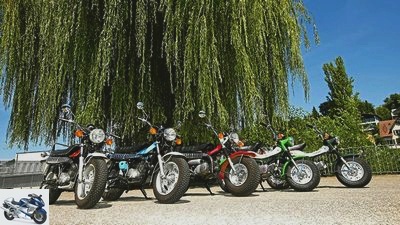
wolf
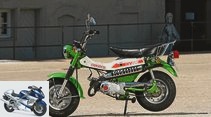
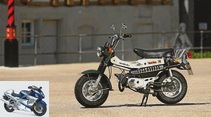
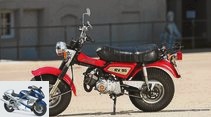
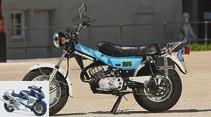
22nd photos
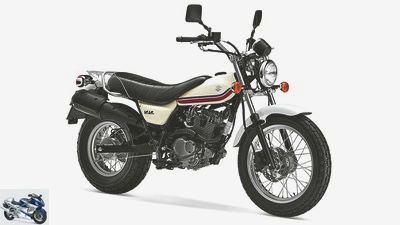
wolf
1/22
With new tire sizes 130 / 80-18 at the front and 180 / 80-14 at the rear, the VanVan drives more precisely.
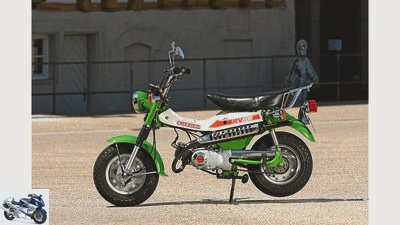
wolf
2/22
The RV is available in all sizes: Suzuki RV 50 …

wolf
3/22
Suzuki RV 75.
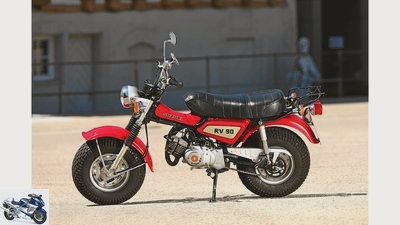
wolf
4/22
Suzuki RV 90.
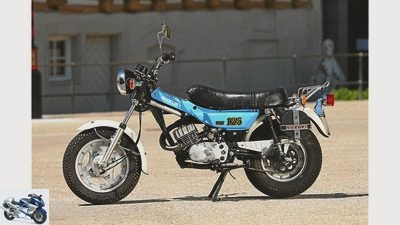
wolf
5/22
Suzuki RV 125.
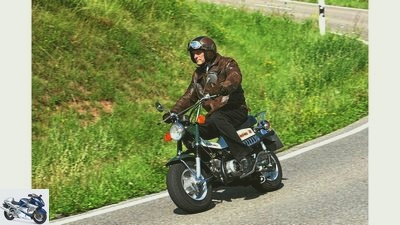
wolf
6/22
The calculation of the RV 75 works: small wheels plus higher performance equals huge driving pleasure.

wolf
7/22
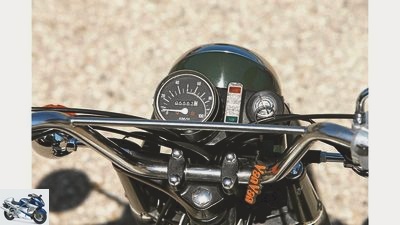
wolf
8/22
The spartan cockpit with integrated ignition lock provides only the most necessary information.
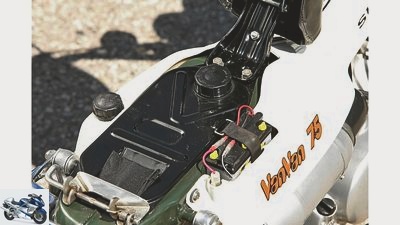
wolf
9/22
The meager 3.5 liters of petrol and 0.7 liters of oil are stored under the fold-up bench.
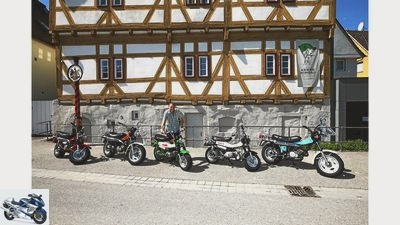
wolf
10/22
Whether in the hustle and bustle of the city or in the dune sand – the RV cuts a fine figure everywhere.
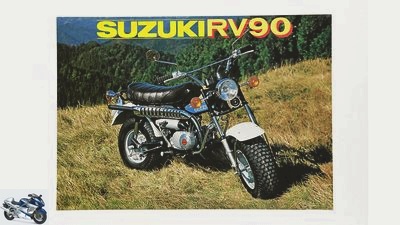
wolf
11/22
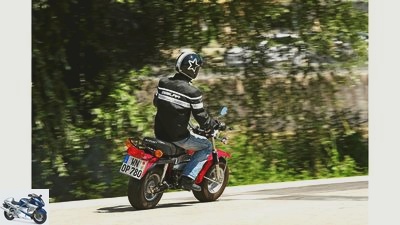
wolf
12/22
Fog thrower: The RV 90 envelops the surroundings generously
in blue two-stroke swaths.
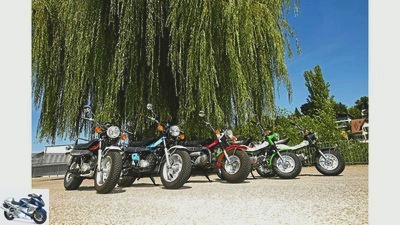
wolf
13/22
An RV always puts you in a good mood and wins the sympathy of all passers-by.
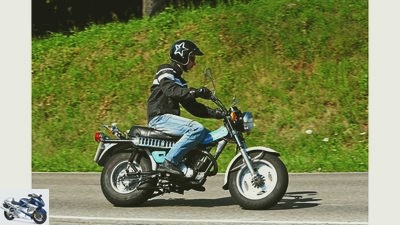
wolf
14/22
The 125cc wants to be pushed in an inclined position – and precise cornering behavior is different.
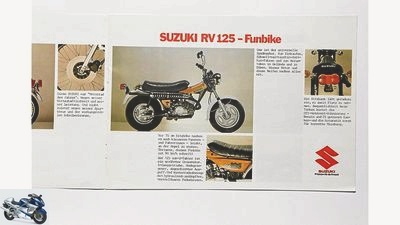
wolf
15/22

wolf
16/22
The tidy cockpit with tachometer falls over the wide handlebars.
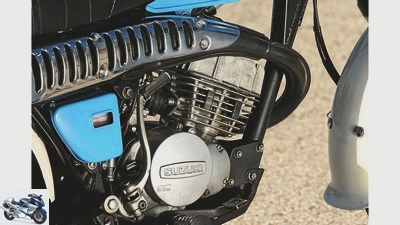
wolf
17/22
You should keep an eye on the level of the battery by looking at the recess in the side cover.
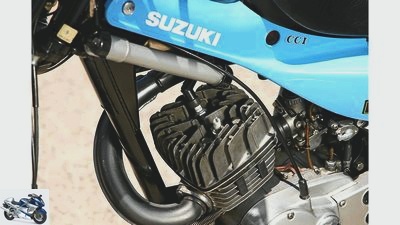
wolf
18/22
Air pump? Available. Spark plug? Even twice.
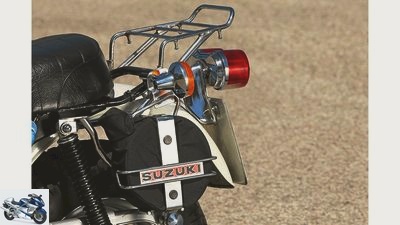
wolf
19/22
The additional tank significantly increases the poor series range.
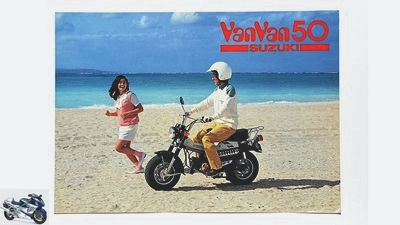
wolf
20/22
In the absence of a beach, as in the original Japanese brochure, German asphalt also works …

wolf
21/22
… It’s fun too.
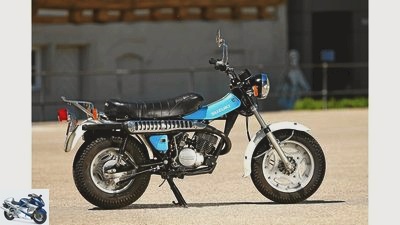
wolf
22/22
Suzuki RV 125, price 1977: 2995 marks.
On the move with Suzuki RV 50, RV 75, RV 90, RV 125
Small speedsters on wide rollers
Content of
At the beginning of the seventies, they came along on broad soles, the fun vehicles from Suzuki. With 50, 75, 90 or 125 cm³, the bizarre two-stroke engines of the RV family rolled bravely through any terrain and conjured up a grin on drivers and passers-by.
F.Geography readers would have a hard time interpreting the tire tracks, drawing conclusions about the type and size of the vehicle, which leaves such wide tracks with a tunnel profile. One would be inclined to guess at least one kind of Hummer on two wheels, an off-road monster, certainly with brute performance. And would be way off the mark. Because even if the largest and strongest representative of the Suzuki RV rolling on wide rollers had left the fat impressions of the studs, only a 125cc two-stroke with a modest eight hp would have been at work here.
Buy complete article
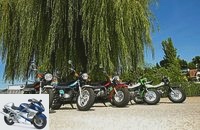
On the move with Suzuki RV 50, RV 75, RV 90, RV 125
Small speedsters on wide rollers
The zipper is available in all sizes
The now 59-year-old only expanded his RV family in 2003, many years later. By chance he came across a Suzuki RV 125. It was standing orphaned in the back of a garage where Zeiher actually wanted to see a completely different bike. What followed is clear: the purchase of the golden 125cc was practically inevitable, the thought of a complete RV collection was sown. In the same year the 90s followed, bought second-hand from a real Cologne resident, which the self-employed gas / water fitter is still amused about today: “A real original, this Cologne jerk”.
One year later, the blue Suzuki RV 125 (built in 1981) joined the collection, and finally Zeiher was able to crown it with an extremely rare Suzuki RV 75, which had never officially been offered in Europe. The RV based on the 50s had made it to Paris via detours, and when Zeiher discovered the exotic’s offer on the Internet in 2010, he didn’t hesitate and brought her home into the lap of the now almost complete RV family.

motorcycles
Test Suzuki RV 125 Van Van
The view thief
read more
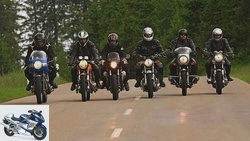
Tourer
On the move: classics of the 70s
Europe wheel
read more
Unusual little speedsters attract attention
All are registered, always ready to drive and today are first rolled through the old town for the planned family photo in front of a historical backdrop. The unusual little speedsters attract the eyes and the corners of the mouth of most of them up. In passers-by of all ages, the Suzuki RVs seem to arouse maternal instincts, in men rather a thirst for adventure. Many a mentally see themselves romping over the extensive sandy beaches of California or at least breaking through the native undergrowth.
We are clearing the field, time is pressing. With the Suzuki RV 50 and the Suzuki RV 90, I only do a few laps around the block – for a driving photo and for a driving impression that at least allows comparisons. The main focus should be on the other two, with whom we want to go out to have fun on the narrow, curved streets through the surrounding vineyards. The Suzuki RV 125 because it is the top model, the Suzuki RV 75 because it is the exotic and with the identical chassis drives exactly the same as the Suzuki RV 50. Only faster.
wolf
Fog thrower: The RV 90 first envelops the area generously in blue two-stroke swaths.
Although: After all, Zeiher’s Suzuki RV 50 already benefited from a larger piston and a displacement increase to 74 cm³, which now gives her a power boost to around five hp and, thanks to a longer gear ratio, the top speed of over 80 km / h required for motorcycle approval . With a lot of run-up and tight-fitting clothing, as Zeiher honestly adds. Reaching top speed may be a tough affair, but the short sprints around the houses with the 50’s are not. The little one comes out of the starting blocks with a lively and happy turn, and is in a good mood from the first meter. It is the only RV that has a reverse gearshift pattern, that is, neutral at the top, first to fourth are shifted down. After initial concentration, you quickly get used to it and enjoy the completely relaxed sitting position and the upright posture behind the wide handlebars.
Taller drivers automatically slide a little backwards on the widening, lushly padded bench. The luggage rack, which is optional in early years of construction and later standard (like this one), helps to utilize the possible load of at least 157 kilograms and to accommodate the luggage. Also available as accessories: panniers, a shopping basket in the front above the headlight, and even a windshield to protect against the “onrushing” wind. The most striking feature, however, remains the ten-inch rollers, which, depending on the intended use (road or terrain), reach a modest 0.8 bar at the front, between 0.8 bar (solo, terrain) and a proud 2.2 bar (with passenger, road) desire. How quickly the studs dissolve into rubber abrasion can be imagined by everyone.
RV stands for “recreation” or “leisure vehicle”
My memories of the Suzuki RV 50 in its heyday are limited to the fact that mate Ralf owned one. I never drove them back then. With her driving performance she did not trigger any storms of enthusiasm in our youth, although the top speed of the 50s increased by five to ten km / h, which was important at the time, to around 55 things after its owner had removed the air filter. But somehow everyone liked the thing. Mainly because it was the first and only two-wheeler known to us that squealed its tires in corners. Well, to be honest, it was probably just a slight whimper of the wide rollers, but it sounded extremely sporty to us. Gummiwutz soon everyone was lovingly calling the small RV, and since then the term has been imprinted as a representative of all RVs that roll on wide rollers.
wolf
You should keep an eye on the level of the battery by looking at the recess in the side cover.
VanVan was its official name in Japan (like all RVs) at the beginning, something like a little truck, which emphasized its character as a small commercial vehicle. The Suzuki RV 90, which I “climb” next (seat height laughable 770 millimeters), rolled to dealers with the addition of “Rover” to its name, which can be translated harmlessly as wanderer, but also more appropriately as Stromer or vagabond. Their rollers look the most imposing, they also measure only ten inches in diameter, but a full 6.70 inches in width. The (just like the 50s) diaphragm-controlled two-stroke engine with its 6.3 hp still does not tear up trees, but in terms of displacement it already draws from the fuller and gets by with even less speed when starting up and strolling around.
As all RVs do not provide the call of screeching, high-revving two-stroke propulsion, but with their engine characteristics correspond to the relaxing driving experience and the purpose. Did I mention what RV actually stands for? For “Recreation Vehicle”, meaning “recreation vehicle” or “leisure vehicle”. It could hardly be called more aptly. The somewhat dull, roaring engine of the Suzuki RV 90 is so stress-free and significantly less vibration than the 50’s that the recovery effect occurs when you sit down on the bench. The RV should actually be available on prescription. I’ll ask my doctor or pharmacist.
The Suzuki RV 125 is a bit more mature than the Suzuki RV 90
The Suzuki RV 90 is not significantly heavier than the Suzuki RV 50, its turning circle of 2.10 meters (RV 50: 1.70 m) is almost as sensationally small that it feels like turning on the bike path – all together tempts you to cheeky hooks in the narrow maze of alleys, and you want to spontaneously slalom around the trees in the adjacent city park. The subsequent escape from the angry law enforcement officers would be rather hopeless in view of the meager top speed of a good 80 km / h. By the way, the RV was even better equipped for off-road adventures at the beginning because it carried the front mudguard up like an enduro bike. In 1974 it was moved down, directly over the front wheel.
For our planned jaunt through the neighboring hill country, we need less off-road capability than more pulling power on the mountain. With the 7.8 hp Suzuki RV 125, which I initially move, I am better off than owner Zeiher, who has folded onto the Suzuki RV 75. I also enjoy the luxury of being able to choose between five courses, which also helps on the mountain.
wolf
Whether in the hustle and bustle of the city or in the dune sand – the RV cuts a fine figure everywhere.
For the first time I can also read in which speed range I’m moving, only the Suzuki RV 125 has a tachometer in the cockpit. The biggest sister is also reserved for the stabilizing girder, which was also donated to the central tubular frame. Even if they seem to be similar, the Suzuki RV 125 is a bit more grown-up than the Suzuki RV 90 in every respect – longer wheelbase and lush dimensions make it the roller queen everywhere. The wide 5.40 at the front, however, with its 14 inch diameter has its pitfalls, the 125 can only be reluctantly pushed into an inclined position, the whole load wants to stand up, and given the low air pressure, the tire flexes noticeably and a precise line is in Difficult to hold corners.
Clearly – the smaller sisters can scurry around better. The drum brakes, which are always best operated together, also need an energetic step or pull on the lever in order to achieve useful deceleration. The performance of the slot-controlled two-stroke engine with the carburettor flanged directly to the engine also develops pleasantly early, it can be driven lazily, but only after 5500 to 6000 tours does the real bite come, which is necessary for brisk progress. After all, the factory specification of almost eight hp is still in the modest range.
The Suzuki RV 125 does not tempt you to lawn
The Suzuki RV 125 does not tempt you to race, the enormously wide handlebars and the relaxed man’s driver’s posture make rolling with three-quarters of the throttle a pleasure, the theoretical top speed of 92 km / h (the factory indicates 90) is hardly of interest. Especially since the chassis qualities and the straight-line stability promise more exciting adventures with increasing speed. Fortunately, the balloon tires, which do some of the work, help the barely damped spring elements to absorb shock on bad slopes. Job? The term appears strange in connection with the RV. There is a holiday feeling as soon as you sit in the saddle. What was yesterday seems far away, the desire for the adventure that beckons around the next bend wins out.
Where is the little sister actually? For a long time she could bravely hold herself in the rearview mirror, but then it got smaller and smaller and gradually it would be time to swap. When you change trains, it’s there again, that grin – what a fun, compact bike. How could you go on tour with it for two? The idea behind the Suzuki RV 75 is as simple as it is grandiose – simply pimp an existing, light and handy bike with more displacement and power into an even faster fun mobile. A half-strong wolf in Mokick fur who wants to live out its pure joy in running. So slide back, knees together, there is no tank to disturb the freedom of the knees.
The two-stroke engine hangs willingly on the gas
The fuel (meager 3.5 liters, 125cc: 4.7 liters) is finally bunkered under the seat, as is the oil supply for the patented separate lubrication system called CCI (Crankshaft Cylinder Injection). The two-stroke valve, which is controlled by a rotary valve and enlarged to 72 cm³, hangs on the accelerator with great willingly. The gears are switched through in no time, and in no time you are in the fourth and last at 65 km / h. From then on it gets a bit tougher, with a lot of run-up the speedometer needle sometimes exceeds the 80s mark. Before the first downhill bend, I brake early, remembering the Suzuki RV 125, but the small simplex drums of the Suzuki RV 75 grip surprisingly hard and are easy to dose.
A completely different world opens up in terms of handling, of course, with the small ten-inch models, the exotic sister literally falls into a lean position and makes me wonder. What would Ralf have given back then to have this engine (Suzuki states 6.5 HP) in his Suzuki RV 50. Clearly: The Suzuki RV 75 is the surprise and the real star of the RV team. The winner of hearts, so to speak. It’s a shame, and a little incomprehensible, that they didn’t exist in Europe. Okay, at that time it just didn’t fit into the German motorcycle world, it was an offer where there was no demand due to the class division. Today it looks different. The demand for RVs is there, but there are hardly any. Interested parties can go on a track search and look for traces of small, 5.40 inch wide studded tires.
In detail: Suzuki RV 125 (1972-1981)
wolf
Suzuki RV 125; Price 1977: 2995 marks.
Data (type Suzuki RV 125)
Engine: Air-cooled single-cylinder two-stroke engine, slot-controlled, bore x stroke: 56 x 50 mm, displacement 123 cm³, compression 6.3: 1, power 5.7 kW (7.8 PS) at 6000 / min, max. Torque 9.61 Nm at 5500 rpm, Mikuni carburetor, Ø 22 mm
Power transmission: Multi-disc oil bath clutch, claw-shift five-speed gearbox, chain drive
Landing gear: Central tubular steel frame with beam, oil-damped telescopic fork at the front, two-arm swing arm made of tubular steel, two three-way adjustable spring struts, tires 5.40-14 at the front, 6.70-12 at the rear, simplex drum brakes at the front and rear, Ø 130 mm
Mass and weight: Wheelbase 1305 mm, handlebar width 810 mm, weight 110 kg with a full tank
Driving performance: Top speed 90 km / h.
Technology: The RV models were presented as fun and leisure vehicles from 1972, as the abbreviation RV (Recreation Vehicle) already reveals. As such, they should also be driven and treated. The technology usually delivers what the robust exterior promises, but a few problems are typical of the entire series. The RVs should generally not be beaten at full throttle over the train. Among other things, the deep installation position of the tank under the seat and the therefore very low pressure drop of the gasoline in the carburetor can lead to insufficient supply and thus to a leaner mixture, which can lead to jamming or burned-out pistons due to the higher temperature.
Incorrect spraying or a spark plug with the wrong heat value can have the same effect. Speaking of spark plugs: Since the 125 cc engine was derived from the motocross model RM 125, the RV engine also has the two plugs in the head so that the plug connector can simply be plugged in when a candle dies. RV drivers use this option to have two candles with different heat values (for short trips or full throttle trips) to choose from. By the way, there is little choice when it comes to tires: Bridgestone tires are difficult or even impossible to find, alternatives are in short supply.
For the Suzuki RV 90, the standard T-Rex tires from Sky Team are a possible option. The lightbulbs of the 6-volt electrical system, which are generally quite susceptible to replacement, are often a reminder. Vibrations and the susceptible regulator of the alternator often kill the lamps in rows. A Kokusan regulator installed to replace the rectifier should help. The solution is often to completely convert to 12 volts and electronic ignition, which at least significantly improves the too dim light. Conversion kits are available from www.powerdynamo.biz for 270 to 290 euros, depending on the model.
Used check: The used check is limited to a few specific points for the RV models. In general, a visual inspection should provide information on whether the bike was beaten too roughly through the terrain – scratches, scrapes and flaking paint from stone chips on the underside and the resulting traces of corrosion could be an indication. If the exhaust system is dented, smacked or rusted, a significant discount must be negotiated – the exhaust can no longer be bought new. It is also important to check whether the original air pump (Suzuki RV 75 / Suzuki RV 125) is available (this is often stolen). In the meantime, it can only be found used with luck and at hefty prices. If you generally value the original condition, you should pay attention to the rear lights, indicators and mirrors. Above all, the original mirrors with the embossed Suzuki-S can hardly be found or only at the highest prices. The replacement of the original shock absorbers with parts from the accessories that may have already taken place, however, can safely be seen as an improvement and is widespread.
Market: The range of used RVs is not abundant, but the fan base is loyal, but manageable. If you want to join the group of RV owners, you have to reckon with prices of around 1000 to around 2000 euros (50s and 90s models), the full-size Suzuki RV 125 is priced around 500 euros higher. The condition is decisive, the mileage of the fun vehicles is usually relatively low anyway. 50s are not recorded as mokicks in the registration statistics, 218 of the Suzuki RV 90 and 327 of the Suzuki RV 125 are currently registered in Germany. The Suzuki RV 75s, which can be counted on one hand in this country (were only sold in Asia, Australia and New Zealand), are not recorded and their price is also difficult to quantify – if you discover an offer, you should grab it.
Specialists:
Powerdynamo GmbH
Telephone 030/50 17 35 20
www.powerdynamo.biz
Hahne power
Telephone 085 44/76 45,
www.hahne-power.de
Hoffi’s 2 stroke shop
Telephone 056 84/93 11 78,
www.2takte.de
Clubs and forums
www.rv50.de
www.suzuki-rv-forum.com
History:
2003: With a politically correct, well-behaved and quiet four-stroke single with 12 hp (from 2007 even with injection), Suzuki revived the cult bike with fat tires as the Suzuki RV 125 VanVan from 2003.
Price: 3300 euros.
Wolfgang Zeiher, owner of the RV models
wolf
The 125cc wants to be pushed in an inclined position – and precise cornering behavior is different.
Wolfgang Zeiher, owner of the RV models
The Suzukis with the little balloon tires excited me from the start because they were so different. I bought the Suzuki RV 50 new at the time, experienced a lot with it, and at least since I converted it to motorcycle approval, it has become my favorite RV anyway. Not least because of their pretty green and white paintwork. You get used to the special driving behavior, you can live with the few technical vulnerabilities if you know how to help. The four-stroke 125cc successor doesn’t appeal to me at all.
Technical specifications
wolf
Air pump? Available. Spark plug? Even twice.
| Suzuki RV 50 | Suzuki RV 75 | Suzuki RV 90 | Suzuki RV 125 | |
| engine | Air-cooled single-cylinder two-stroke engine, compression 6.3: 1 | Air-cooled single cylinder two-stroke engine, compression k. A.. |
Air-cooled single-cylinder two-stroke engine, compression ratio 6.2: 1 | Air-cooled single-cylinder two-stroke engine, compression 6.3: 1 |
| Gas control | Membrane controlled | Rotary valve controlled | Membrane controlled | Slot controlled |
| Bore x stroke | 41 x 37.8 mm | 47 x 42 mm | 50 x 45 mm | 56 x 50 mm |
| Carburetor / passage | Mikuni / 14 mm | Mikuni / 16 mm | Mikuni / 17 mm | Mikuni / 22 mm |
| power | 2.7 hp at 5000 rpm | 6.5 hp at 6000 rpm | 6.3 hp at 6000 rpm | 7.8 hp at 6000 rpm |
| Tire size v / h | 5.40-10 / 5.40-10 | 5.40-10 / 5.40-10 | 6.70-10 / 6.70-10 | 5.40-14 / 6.70-12 |
| Weight | 88 kg (full tank) | 96 kg (with full tank | 98 kg (with full tank | 90 kg (with full tank |
| Top speed | 40 km / h (factory specification) | 84 km / h (factory specification) | 84 km / h (factory specification) | 90 km / h (factory specification) |
| Factory price | 1980 Mark (1977) | k. A.. | 2450 Mark (1975) | 2995 Mark (1977) |
Related articles
-
Two-stroke Benelli 250 2C, Maico MD 250 and Suzuki GT 250
Wolf 48 pictures Wolf 1/48 Suzuki GT 250. Wolf 2/48 The once praised disc brake now looks a bit dull and toothless. Wolf 3/48 The brave …
-
On the move with the Honda MVX 250 F.
Wolf 29 pictures Wolf 1/29 The MVX was not a big seller, but the speedster with the V3 engine is still a lot of fun. Wolf 2/29 Wolf 3/29 Wolf …
-
Hercules W 2000, Norton Classic, Suzuki RE5, Van Veen OCR 1000
wolf 47 photos wolf 1/47 The mighty radiator for the 4.5 liters of coolant shapes the front, but keeps the temperature balance in order. wolf 2/47 Brembo…
-
Air-cooled big bikes Kawasaki GPZ 1100 UT, Laverda RGS 1000 and Suzuki GSX 1100 EF
fact 48 pictures fact 1/48 The engines are the stars, they still exude charm and, in the case of GPZ, RGS and GSX, clearly inspire …
-
Suzuki RG 500 and Suzuki GSX-R 750 in comparison
MOTORRAD CLASSIC on the move: Suzuki sport motorcycles 1984 Competitors: Suzuki RG 500 and Suzuki GSX-R 750 Content of Suzuki presented the…
-
wolf On the move: Hercules K 125 T The Nurnbergerle Content of At that time the Hercules K 125 T was light home cooking; if not exactly the dream…
-
Comparison test: Honda CX 500-650 Turbo, Kawasaki Z 750 Turbo, Suzuki XN 85, Yamaha XJ 650 Turbo
Jahn 21 pictures Jahn 1/21 The preload of the central spring strut of the Suzuki can be easily adjusted. Jahn 2/21 Tight corners and fast …
-
Suzuki GSX-R 1000 R in the driving report
Suzuki 27 photos Suzuki 1/27 Suzuki GSX-R 1000 R. Suzuki 2/27 Suzuki GSX-R 1000 R. Suzuki 3/27 Suzuki GSX-R 1000 R Suzuki 4/27 Suzuki GSX-R 1000 R….
-
Athletes in comparison: Yamaha TRX 850, Kawasaki ZX-.6R, Suzuki GSX-R 750, Honda CBR 900 RR
Athletes in comparison: Yamaha TRX 850, Kawasaki ZX-.6R, Suzuki GSX-R 750, Honda CBR 900 RR offensive Stronger, faster, lighter is the maxim in the…
-
Blacksmith Suzuki M 1800 R Intruder Endurance test interim balance Cast off for a long-term trip with the Über-Cruiser, which has the thickest pistons in…